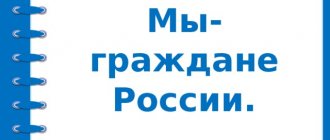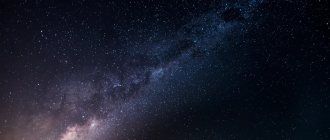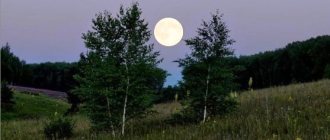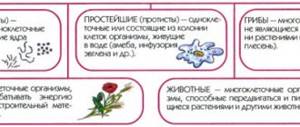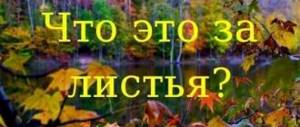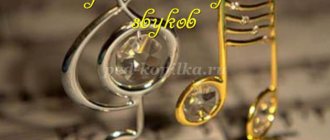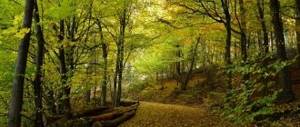Lesson summary on the topic: “Seasons”
Lesson topic : Seasons. Change of seasons.
TASKS:
- To form in students an idea of the changing seasons;
- Show students that the movement of the Earth around the Sun is the reason for the change of seasons on the planet;
- Develop observation, attentiveness and research skills in students;
- Continue to develop your ability to work with a textbook;
- Instill a caring attitude and love for nature.
EQUIPMENT:
- Tellurium (Sun-Earth-Moon model) is a moving model of the relative position of the Sun, Earth and Moon in various phases of their rotation. Allows you to clearly demonstrate: the change of seasons, day and night, phases of the moon, solar and lunar eclipses;
- Illustrations of nature at different times of the year
- Globe;
- Textbook.
DURING THE CLASSES
I. Organizational moment.
II. Updating basic knowledge.
Checking homework:
- Why does day and night change on the planet?
- What natural phenomena repeat every day?
- How many times does the Earth rotate per day?
- Does the length of night and day change in winter?
III. Announcing the topic and main objectives of the lesson.
Choose the only correct conclusion from the following three:
- Night comes because the Moon appears in the sky.
- The sun revolves around the planets.
- Day and night occur because the Earth rotates on its axis and is illuminated differently by the Sun. (The last output is correct.)
Consolidating new information using the question-answer method:
- What movements of the Earth do you know?
- (Movement around its axis, movement around the Sun.)
- What does movement around its axis lead to?
- (To the change of day and night.)
- What does the movement of the Earth around the Sun lead to?
- (We don't know yet.)
- What do you think the lesson will be about?
- (We learn what happens on the Earth as it moves around the Sun.)
There are 4 illustrations depicting the seasons on the board. The teacher asks the children riddles.
The water turned into ice The bear stopped roaring: The bear fell into hibernation in the forest. Who can say, who knows, When this happens?
(Winter)
I open the buds into green leaves, dress the trees, water the crops.
(Spring)
I am woven from the heat, I carry the warmth with me, I warm the rivers, “Bathe!” - I invite you.
(Summer)
I bring the harvests, I sow the fields again, I send the birds south, I strip the trees.
(Autumn)
Guessing riddles is accompanied by showing illustrations. Well done guys, today in class we will talk about the seasons and try to answer the question: For what reason do they change?
IV. Learning new material
People have long been interested in knowing why it is warm in summer and cold in winter, why summer days are long and nights are short. As time passed, it became known that the Earth revolves around the Sun and at the same time rotates around its axis, in a circle from right to left (counterclockwise, when viewed “from above” in the northern hemisphere). This is why the change of day and night, as well as the change of seasons, occurs on Earth (it is recommended to show it visually, using a globe and a flashlight - very effective!).
If we imagine a line from the North Pole to the South Pole, then we will get the foundation on which the Earth actually rests - this is the earth's axis. It is inclined to the plane of the Earth's orbit at an angle and is always directed towards the North Star. Because the position of the Earth's axis is tilted constantly in the same direction, the Sun illuminates the Earth's surface in different ways. A complete revolution of the Earth around the Sun occurs in 365 days and 6 hours, and around its axis in 24 hours.
In this regard, there are 4 seasons on Earth. Let's call them (spring, summer, autumn, winter). If in summer the Northern Hemisphere is turned towards the Sun, the rays fall directly, we find ourselves on a well-lit surface of the Earth, respectively, with long days and short nights. During this period, active growth and reproduction of the plant world begins. And in winter, the Northern Hemisphere, passing through its orbit, turns away from the Sun, the sun's rays lightly touch the Earth, accordingly the day is short and the night is long. There is a calm, nature is sleeping. When the rays of the Sun illuminate the Northern and Southern Hemispheres evenly, autumn and spring begin there.
Another main point is the presence of days when the Sun occupies its highest (lowest) position above the horizon.
- June 22 – summer solstice;
- December 22 – winter solstice;
- March 22 and September 22 are day equal to night; these are the days of the spring and autumn equinox.
A complete revolution of the Earth around the Sun takes 365 days and 6 hours. We know that there are 4 seasons in a year, each with three months. Name them. Our ancestors had completely different names for the months, try, guess, explaining some of the names (sechen, lute, berezozol, pollen, grass, worm, linen, serpen, veresen, leaf fall, breast, jelly).
Next, it is recommended to carry out practical work using a globe and a flashlight. Children with a teacher look on the globe for the place where they live. Collectively they find out how the model of the earth should be located at different times of the year, while describing the main distinctive features of each season (weather, nature, temperature, life of animals and people).
Questions to consolidate information:
- What movements does our Earth make?
- How many days does a year last?
- Explain why there are seasons. Name them.
- Remember what you know about the movement of the Earth around its axis.
- What are the seasons?
- People have long noticed that when the sun rises high in the sky, it is warm on the earth, and when it sinks low, it is cold.
- Why do the warm seasons (spring, summer) change into cold seasons (autumn, winter)?
- Why does the Earth receive unequal amounts of heat and light from the Sun at different times of the year?
- When the sun's rays hit directly, the sun is hotter. If the rays of the sun fall on the earth's surface at an angle, then they heat the earth's surface less. This is why the seasons on Earth change. How long does it take for the Earth to revolve around the Sun? What is this time called?
In preparation for the lesson, the article will be useful: How the seasons change
2. Physical education minute
V. Systematization of knowledge
Demonstration of the change of seasons on Earth using tellurium:
- Children! Look at this device.
- How many of you know what it's called?
- (Tellurium)
- Say the word in chorus.
- Today you will be able to reveal the secret of why I brought this particular device to this lesson.
- (The teacher turns on tellurium.)
- I want to hear your opinions.
- What are your assumptions?
- (Model of the Earth and the Sun, -tellurium depicts how the Earth rotates relative to the Sun.)
- What role will the lamp play?
- (The lamp plays the role of the Sun.)
- Let's draw a conclusion. Talk about how the rays fall on your hand.
- (In the first case, the rays fall directly on the hand, and in other cases the rays fall obliquely.)
- So why was the hand warmer in the first position?
- (Because the rays were straight, and the hand was closer to the heat source.)
- Let's perform the same experiment with a globe - a model of the Earth. The globe has an imaginary axis around which the Earth rotates.
- Let's follow the rotation of the globe.
- Where does the Earth’s axis “look”: towards the Sun or away from it?
- (From the sun).
- What do you think the sun's rays bring: light, heat, or both?
- (Both light and warmth.)
- Let's determine where it is warmer in this position of the Earth: in Africa or in Antarctica.
- (Africa is warmer.)
- Let's continue observing the rotation of the globe around the Sun.
- Does the earth's axis point toward the Sun or away from the Sun?
- (On the Sun.)
- While our hemisphere is turned towards the Sun, our days are long, the rays are straight, and the season is summer. While our hemisphere is facing away from the Sun, our days are short, the rays are oblique, and the season is winter.
- How long will it take for the Earth to complete its revolution around the Sun?
- ( In a year.)
- How long is a year?
- (12 months).
- So, what happens as the Earth rotates around the Sun?
- (Change of seasons.)
- What is the main reason for the change of seasons?
- (The tilt of the earth's axis and the movement of the earth around the sun.)
- Why do days last longer in summer?
- (The sun rises high above the horizon.)
- Why is it cold in winter?
- (The sun is low on the horizon.)
VI. Summarizing
- How does our Earth move?
- What is the reason for the seasons?
- What are the seasons?
- How many days are there in a year?
There are 4 climate zones on Earth:
- The equatorial zone is the hottest, where drought occurs in spring and autumn, and high humidity in summer and winter.
- Tropical zone - hot and dry almost all year round. However, once a year there is a rainy season - the coldest season of the year.
- Temperate zone - this includes Western Europe and the central part of Russia. In spring and summer it is relatively dry with short-term precipitation; in autumn and winter a huge amount of it falls in the form of rain and snow.
- The Arctic and Antarctica - in this part the seasons do not change, only the change of day and night occurs, since the weather conditions are the same throughout the year, the temperature is always below zero.
VII. Reinforcing the material covered.
The path in which the Earth revolves around the Sun is called an orbit. The change of seasons is an eternal and unchanging phenomenon of nature. Its cause is the movement of the Earth around the Sun, which lasts 365 days, or a year.
- Why does the change of day and night occur?
- Why do the seasons change?
- When it's summer in the Northern Hemisphere, what season will prevail in the Southern Hemisphere? (winter).
- If it is spring in the Northern Hemisphere, then in the Southern Hemisphere? (autumn)
- Where does the Sun shine the same throughout the year? (near the equator)
- Explain what would happen if the earth's axis was vertical? (seasons would not exist. Because any point on the globe, on the illuminated side, would be equally distant from the Sun. Accordingly, the air would warm up evenly).
- What climate zone do we live in?
VIII. Solving Natural Problems
- You washed the blackboard in the classroom. She's wet. Where did the water go?
- Let's think about whether there is a water cycle in winter.
- (Students' answers.)
- Can water evaporate at low temperatures?
- ( No)
- Why do housewives hang washed laundry outside in winter?
- (Dry)
- Is it drying out?
- ( Yes)
- This means the water evaporates.
- In nature, water can pass into a gaseous state not only from liquid, but also from solid: from snow and ice.
- In winter, in what form does water return to the earth?
- (In the form of snow).
- And snow is water. The water cycle is endless!
IX. Homework
Read the material in the textbook, compose an oral story about the friendship of the Earth and the Sun, find riddles and proverbs about the seasons.
Thank the children for the lesson and give grades.
X. Lesson summary.
Thank the children for the lesson and give grades.
Notes on the world around us on the topic: “Holidays for everyone” (2nd grade of the educational complex “Perspective”).
10/12/2016
Lesson #12.
Topic: Holidays for everyone.
Target:
teach to identify the difference between Russian public holidays and international holidays.
Subject results:
- briefly characterize the content of general civil holidays of the modern Russian calendar presented in the textbook.
Meta-subject results:
- describe the celebration of one of these holidays in your city.
- illustrate the story with photographs (computer presentation).
- determine the difference between Russian public holidays and international holidays.
Personal result
- understand the importance of the holidays of the modern Russian civil calendar as a way of friendly unification of all citizens of our Fatherland, regardless of place of residence, characteristics of ethnic culture and religion.
Equipment:
dolls Anya and Vanya in national costumes; Wall calendar; state symbols of Russia; holiday paraphernalia (balloons, garlands, flags, posters, holiday cards, carnival masks), tape recorder, textbook, workbook on the world around us, colored pencils, calendar exhibition.
During the classes.
I. Organizational moment. (slide 1)
-Performance by a group of girls with the dance “Matryoshka”. (slide 2)
— Guys, in previous lessons we got acquainted with the calendar, learned about the past time, how people lived, what they did and how they planned their vacation, what holidays they celebrated. We found out that the Russian people are hardworking, cheerful, and know how to not only work well, but also have fun from the heart. Well, what fun would it be without a Russian song, a Russian dance, a feast, that’s why we started our lesson like this in Russian, festively. And if they let fun into the classroom, then it’s for a reason. Today in class we will talk about holidays.
II. Updating knowledge and skills. (slide 3)
1. Introductory speech by the teacher.
- What is a holiday? Where can we find the correct interpretation of this word?
Student. - In dictionary.
- That's right, in the dictionary. We have the opportunity to access a “live” dictionary. We have Maxim as a dictionary. He received homework for this lesson: find the interpretation of the word “holiday”.
— Last year we already addressed the topic “Holidays” in Local History classes, when we talked about our family, about family traditions, about family holidays. Let's take a look at the family album and see what holidays are celebrated in your families.
— Birthdays, parents’ wedding day, City Day, New Year, Women’s Day on March 8, Preschool Worker’s Day, Doctor’s Day, Victory Day, Knowledge Day, etc.
- What a variety of holidays in their content...
2. Work in groups. (slide 4)
-Do you think there are many holidays in our country?
-Which holidays do you like most?
-You have the names of the holidays on your desks. Try dividing them into groups.
-What groups will we single out?
1. Family (birthdays, weddings, parties).
2. Professional (Teacher's Day, Archaeologist's Day, etc.).
3. State (Defender of the Fatherland Day, Russia Day, Constitution Day, Victory Day, etc.).
4. National (Mother's Day on November 29, April Fool's Day, April 1, Knowledge Day on September 1, Student's Day on January 25, Family, Love and Fidelity Day on July 8, etc.).
— Are there any holidays that are celebrated by the whole country, by all people living in the Russian Federation?
You probably noticed that our old friends are visiting us today: Anya and Vanya. They came to us in national Russian costumes and not by chance, because we will talk about holidays that our whole country celebrates. As always, they have already prepared attentiveness questions for us, which we will answer at the end of the lesson. Therefore, I suggest everyone to be careful.
— Guys, how do the residents of our country learn about all the holidays?
The most reliable source is the calendar.
I draw your attention to the exhibition
ku. You have already become acquainted with different types of calendars: name them (church, table, wall, pocket, tear-off calendar, etc.)
III. Getting to know new material.
— Let us also turn to the calendar, the keeper of time, for help. But first, let's remember in what order the months go. To do this, I need 12 assistants who have received a game name - the name of the month and who will help me in the lesson. And the rest will help them get up in order.
Analytical stage.
Now that we have remembered the order of the months, we can go on a journey through the calendar.
— Look, the calendar dates are marked in different colors. Some are printed in black ink, others in red. Why? Why are holidays and weekends highlighted in red? (red color means holiday; red is beautiful, red color is clearly visible).
— show the location of dates in the calendar.
But there are also holidays on working days. Such days are called red days of the calendar .
IV. Working with the textbook
.(pp. 40 – 41). -read what holidays the whole country celebrates, regardless of nationality, place of residence and religion.
The purpose of our lesson: to get acquainted with the holidays that our whole country celebrates, to determine the difference between public holidays in Russia and international holidays, to understand the importance of them as a way of friendly unification of all citizens of our Fatherland, regardless of place of residence.
You conducted research on the topic “Holidays”. Today in class we will hear what conclusions you came to and see the results of the research.
You are ready? Which group should we start with? Let the Calendar, whose role we have entrusted to Vitalik, judge us. So, the Calendar announces the red date in a certain order, and the corresponding group of guys shows the emblem, names the holiday and talks about it.
(Presentation).
1 group. January 1 – New Year. (Slide 5).
This holiday is familiar to you, because it is celebrated in every family. In the last lesson we learned in detail about this holiday. And the guys have already told us about it.
Each holiday has its own decorations and its own music. For example, what is suitable for celebrating the New Year (toys, garlands) will not be suitable for the holidays of Victory Day and Defenders of the Fatherland Day.
Let us name only the symbols of the New Year holiday.
The main character of the holiday, Father Frost (European Santa Claus), came to us from the West in the second half of the 19th century. Initially, he was just a fairy-tale character, but so impeccable in his kindness and generosity that he wanted to be animated. And the Russian people “dressed” him in a smart red fur coat, a fluffy hat and down mittens.
And so that it would not be difficult for him, a Russian, to entertain children on New Year’s Eve, he had a granddaughter, Snegurochka, a sweet and cheerful girl, whom everyone immediately fell in love with for her kindness.
2nd group. February 23 is Defender of the Fatherland Day. (Slide 6).
February 23 is Russian Army Day! The guns are firing upward, everyone is treated to fireworks. They send gratitude from the whole country to the soldiers,
The holiday of all our soldiers - That's what this day means! Day of Defenders of the Brave and just all the guys!
February 23 is the Day of Military Glory of Russia, which Russian troops gained on the battlefields. Initially, this day contained a huge meaning - to love, honor and defend one’s Fatherland, and, if necessary, to be able to defend it with dignity.
Soldiers had to defend their native Russian land very often, but the Russian soldier always fulfilled his duty with honor. And today the Russian Army reliably protects its country from all enemies and protects the priceless heritage of the world. For this holiday, it is customary to open new exhibitions in museums, exhibitions of painting, sculpture, and feature film festivals on relevant topics.
Symbols are an armed soldier or military equipment.
3rd group. March 8 is International Women's Day. (slide 7).
In the 19th century, there was no question that women had any rights. Women were prohibited from participating in elections and holding leadership positions. Women worked 16 hours a day, while receiving pennies. In 1908, the first March demonstration of women took place in New York City demanding equal rights with men.
The decision to celebrate International Women's Day annually was made in 1910 at the Second International Women's Conference. This holiday has long lost its political connotation, and we celebrate it as a holiday of Spring, Love, and Beauty.
On this day, men give flowers and gifts to women.
Teacher: Back in the spring
In 1857, workers in New York's clothing and shoe factories staged the "Empty Pan March" to demand higher wages, better working conditions, and equal rights for women. This was the first Women's Day. And fifty years later, in February 1908, thousands of women again took to the streets of New York, and were already demanding the right to participate in elections, improved working conditions, and the abolition of child labor.
On February 23, 1917, Russian women took to the streets demanding “Bread and Peace.” It was this event that determined the date of the celebration (after the revolution of 1917, Russia switched to a new calendar and International Women's Day began to fall on March 8). This is how the “male” and “female” days turned out to be close. Gradually, the tragic history of the holiday associated with the struggle of women became a thing of the past, and International Women's Day began to be perceived as a holiday of all women. This is how we know him today.
VI. Consolidation of what has been learned.
Teacher:
We briefly got acquainted with the holidays that are celebrated by all peoples in the Russian Federation.
- — Now let’s answer the questions of our assistants:
- How do people know that today is a holiday or a weekday?
- How do public holidays differ from international ones?
- What are the international holidays that are celebrated in our country?
- What do these holidays have in common? (they are of particular importance, celebrated by a wide range of people, i.e. they are for everyone)
2) Game “Find out the holiday.”
- turn on the music, children guess the holiday and name the date.
Conclusion . The calendar is a faithful guardian of memory. It reminds us of the most important events in the life of our Fatherland. The calendar helps us feel like citizens of one beautiful country - Russia.
VII. Lesson summary. (slide 24)
— What new did you learn in the lesson?
— What holidays are common to all Russian citizens, regardless of faith, nationality, or place of residence?
What do these holidays have in common? (These holidays are associated with the history of the people, their culture, and traditions.)
VIII. Making marks.
IX. Reflection. (slide 25)
-Use the “Ladder of Success” to evaluate your work in class.
- now show with emoticons what mood you are in, in other words, how successful and interesting the lesson was.
X. D/Z.
pp. 40-43, in the textbook, familiarize yourself with the features of the holidays for all residents of our country, in the workbook, on pp. 28-29 - draw the symbols of each holiday.
11
